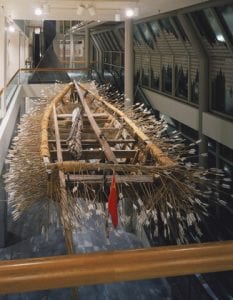Though Cai Guo Quiang was made famous for his works with gunpowder and other explosives, he also worked with a vast series of other mediums, most of which included taking traditional objects of Chinese and other cultures and transforming them into a more thematic message through sculpture and arrangement. Borrowing Your Enemy’s Arrows (1998) is a piece that depicts a traditional Chinese fishing boat, that is suspended from the ceiling. The boat itself looks to hang about five feet above the heads of an average human, and is missing many pieces of wood from its frame. This is important to note seeing as this lack of structure means that the boat will never be able to float again, and instead will sink due to the amount of water that could potentially leak in. The boat is surrounded by 3,000 arrows that pierce into the wood, that are also reinforced by thick pieces of rope that wrap around the limbs of the ship and the bodies of the arrows themselves. At the front of the boat is a small Chinese flag that is constantly blowing due to a plug in fan. When looking at the boat, often times the flag itself is not visible due to the fact that the thousands of arrows that penetrate it, surround the reds of the Chinese symbol, and mask it from viewers unless it is directly being viewed. Cai himself, when asked about the painting mentioned that he believed it acted as a sort of symbol for cultural conflict. (Friis-Hansen 2007: 26) (Wedell-Wedellsborg, 10) This being said however, there are more than a few ways to interpret this piece. One of the many is the idea that it could potentially be based off of a classic Chinese story called “The Story of the Three Kingdoms (Chinese: San guo yan yi), in which the brilliant strategist, Zhuge Liang, secured the enemy´s arrows for his own army by luring the enemy into firing their arrows into an unmanned straw boat.” (Wedell-Wedellsborg, 11) This would lead to a view that would put China, and this piece as the head power, one that is able to outsmart any competitor, and can lead in any circumstance. The author of the journal however said that she believes that this piece is actually about how China itself is damaged, staying afloat, but slowly sinking. (Wedell-Wedellsborg, 11) Once again, there are many ways to interpret this piece, but it depends on the person at hand to do so.
Sources:
Wedell-Wedellsborg, Anne. “Contextualizing Cai Guo-Qiang .” Contextualizing Cai Guo-Qiang , 2010, kontur.au.dk/fileadmin/www.kontur.au.dk/Kontur_20/Microsoft_Word_-_VAM-WEDELL_MOD2.pdf.
“Scenes for a New Heritage.” Lee Bontecou. Untitled. 1959 | MoMA, www.moma.org/audio/playlist/182/2436.
Cai Guo-Qiang, Borrowing Your Enemy’s Arrows (1998)



February 1, 2019 at 5:28 pm
This is very interesting, and makes me think of the works that I am studying created by Huang Yong Ping. When you mention that he takes traditional Chinese works and makes them his own, it makes me realize that maybe this was more common in Chinese art than I thought. Huang Yong Ping also took specific traditional Chinese symbols and created his own work from them to convey specific messages that he believes in, whether political or more spiritual.This is shown through his works when he put the two books in the washing machine to create them into one. One book was on modern Chinese and the other was on traditional Chinese. He wanted to get rid of the differences so he created a sculpture out of what came out of the washing machine. The reflection on this work makes me want to dig deeper into Huang Yong Ping’s sculptures to see if there are underlying meanings that are not detected at first glance.